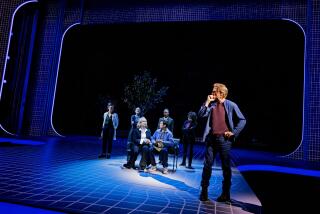PERFORMANCE ART : ONE MAN’S ODYSSEY IN THE ‘BUDDY’ WORLD
- Share via
For Tim Miller the line between creative fancy and confessional document is a thin one, perhaps an inseparable one, perhaps even a pointless one.
But it’s easy to see how both forces, creating and confessing, energize the completed version of his “Buddy Systems,” which opened a three-week run Saturday at Hollywood’s Cast-at-the-Circle Theatre.
He is not alone, this performance artist whose feverish rant and childlike simplicity mark the trail to self-revelation.
Consider for a moment Philip Roth, Jean Genet, Woody Allen, Ingmar Bergman and Jules Feiffer. Then imagine, not a film or novel, but a rough-and-tumble studio production about Tim, not Odysseus, discovering himself. First in infancy, as a mass of non-judged impulses with gratified needs. Later as an adolescent, registering bewilderment over his discord with the universe. And finally as an adult trying to break down his defenses against the buddy system.
It is the buddy system, after all, that we live by. Two, together, in the treacherous waters can mean survival.
For Miller and his mate Douglas Sadownick, who people this two-character, real-life saga, confession subdues the battle only partially; it doesn’t wipe away the ambivalence or doubt or destructive compulsions the two grapple with.
But watching this collage of poetic monologue, abstract movement, song-and-dance satire, unabashed exhibitionism and just-plain-melodrama, one is drawn into the heat of immediacy and intimacy. The hourlong work, played out in a small space in hyper-realistic style, transcends any notion of formality. And one is convinced of its therapeutic value to Miller, the auteur and primary participant.
The diary as performance art, in imaginative hands, can be compelling. And despite a certain throwaway crudeness to this multimedia production there is enough catharsis in the raw telling to ensnare the viewer.
In the beginning Miller disarms with his description of “the glob theory of human development”: people as amorphous “globs” who later determine they are boy globs or girl globs “wanting to do it with other boy globs or girl globs,” as the case may be.
The autobiographer manages to use all the sordid teen-age events that scathed him as the impetus for a powerful romantic conversion. Finding his way from despair (a sleazy pickup) to the star-filled night of Wagnerian glory at Hollywood Bowl via “a big lady” singing the “Liebestod” brought him an epiphany.
At later stages he works through his inability to form attachments, tracing it historically to a boyhood dog he abandoned, then to the current one called Buddy, whose biscuits he chews and water he slurps from a bowl.
What comes across ultimately is a picture of Miller questing and testing, with Sadownick trying to stabilize the relationship by defeating his partner’s rationalizations.
But this portrait of the performance artist really bears on a specific dilemma: How to stay. Staying is a heavy order, especially when it denies the overwhelming impulse.
Buddy systems work, though. Life probably is a swimming lesson.
More to Read
The biggest entertainment stories
Get our big stories about Hollywood, film, television, music, arts, culture and more right in your inbox as soon as they publish.
You may occasionally receive promotional content from the Los Angeles Times.










